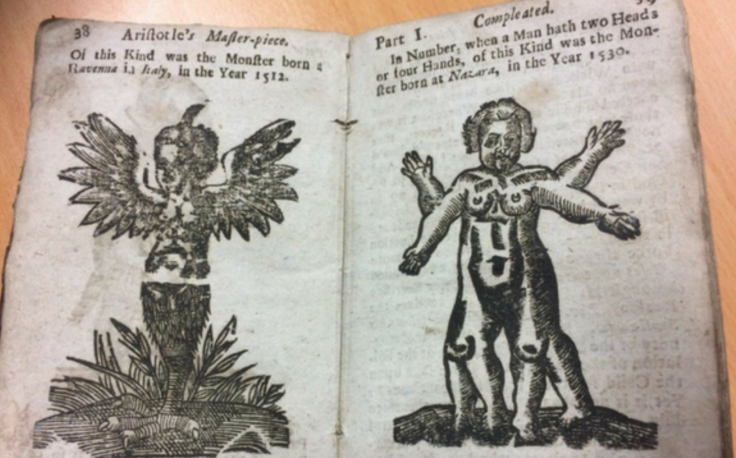Rare 300-year-old 'sex manual' features monsters and witchcraft
The banned English book features elements of witchcraft, astrology and religion.

A 300-year-old "sex manual" that was banned until the 1960s due to its shocking content featuring magic and myth, is set to be sold in a UK auction next month.
The 1720s book, entitled Aristotle's Masterpiece Completed In Two Parts, The First Containing the Secrets of Generation was first published in London. It includes explicit old wives' tales and sexual advice laced with elements of witchcraft, astrology and religion.
The weathered book, which has an estimate of £80-£120, will go under the hammer on 27 March at Hansons Auctioneers, Etwall, in Derbyshire.
"The first edition was published in 1684 and it was as good as banned until the 1960s. There were several reasons for that," said Jim Spencer, valuer at Hansons.
"For example, it includes woodcut illustrations of 'monsters' that 'are begot by women's unnatural lying with beasts' - an example being a woman 'generating with a dog'.
"A century after women first won the right to vote in the UK, this book takes us back to very different times. It talks of man being 'the wonder of the world, to whom all things are subordinate'. Meanwhile women are painted as being prone to sexual indulgence."
The book suggests that parents' thoughts during sex can impact on the children's own appearance, saying that the "force of imagination" could produce a child with "a hairy lip, wry mouth or great blubber-lips".
It recommends a number of foods to aid sexual performance, such as eggs, sparrows, blackbirds, gnat snappers, thrushes, partridges, parsnips, young pigeons, ginger and turnips.
The text also claims that pregnant women have "greedy longings for things that are contrary to nutriments" which, it noted, included "leather, man's flesh and horse flesh".
Somehow, it even has sections containing old-fashion romantism, stating: "Without doubt, the uniting of hearts in holy wedlock is of all conditions the happiest, for then a man has a second self to whom he can unravel his thoughts as well as a sweet companion in his labour".
Spencer added: "There are several illustrations of beast-like creatures including a man sporting a bushy dog's tail and a monster being born in Ravenna, Italy, in 1512.
"This is blamed on 'filthy and corrupt affection'. But you have to bear in mind that this book was written when people were still being burnt for witchcraft in Georgian England."





